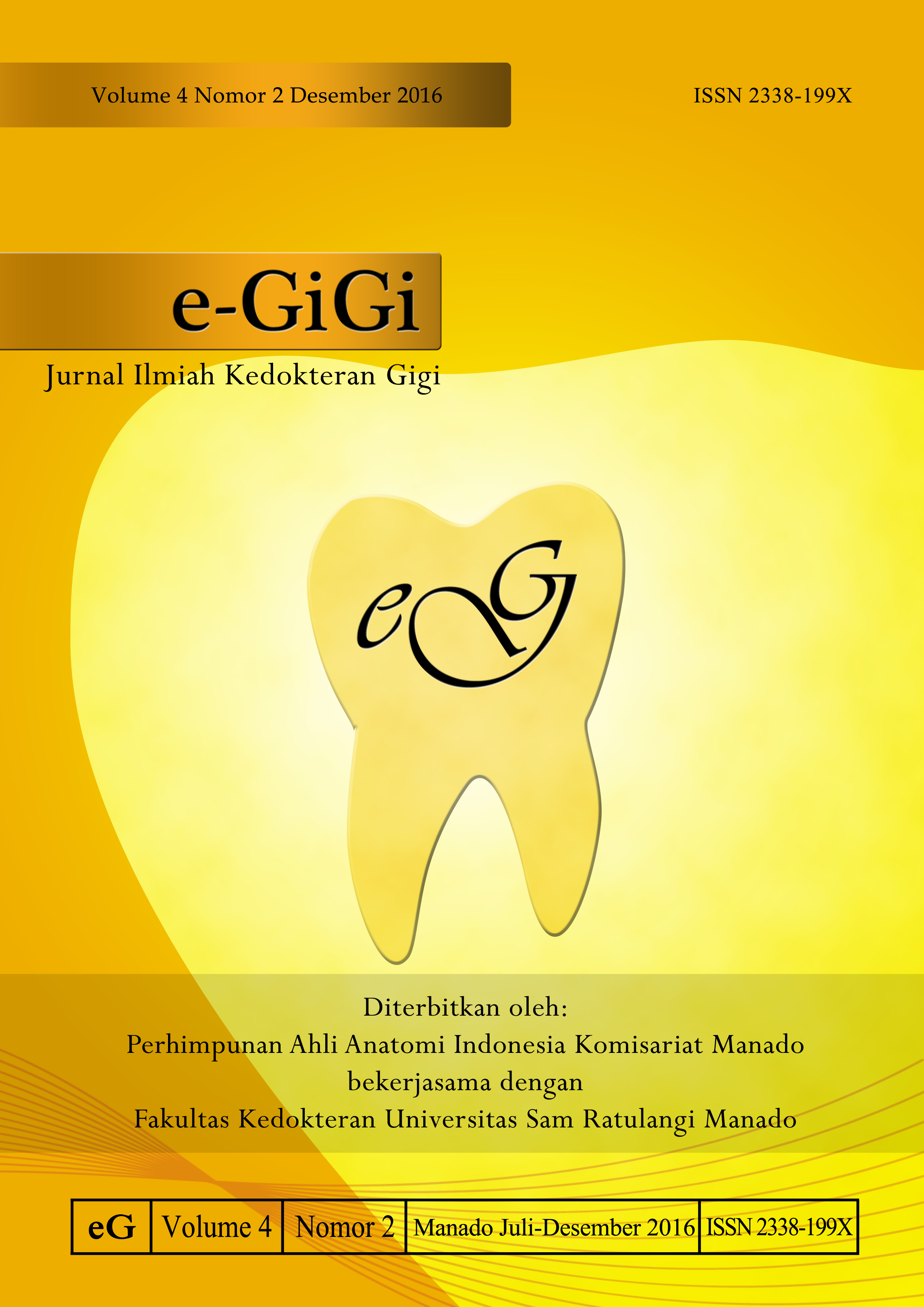Ukuran dan bentuk lengkung gigi rahang bawah pada orang Papua
DOI:
https://doi.org/10.35790/eg.4.2.2016.14163Abstract
Abstract: Mandibular size and shape are important information especially in terms to figure out the right diagnosis and the type of treatment a patient should have. Human mandible is a key factor for occlusion adjustment, meanwhile maxilla is following the mandible’s position. Several studies show that the stability of mandibular shape and size determines the success of one’s treatment. Each ethnic group has a particular skeletal pattern as well as shape and size of mandible. This study was aimed to obtain the average size and shape of mandibles among local Papuans. This was a descriptive observational study with a cross-sectional design. Samples were obtained by using purposive sampling method. There were 35 local Papuans aged 18-25 years as subjects. Data were obtained by molding the subject’s mandible, therefore, each subject produced a study model. The study model was measured in sagittal (length) and transversal (width) views based on Raberin method. The results showed that the average lengths of local Papuans’ mandibular size in sagittal view (L31, L61, and L71 in a row) were 6.143; 26.463; and 43.743 mm meanwhile the average widths of local Papuans’ mandibular size (L33, L66, and L77 in a row) were 30.857; 50.971; and 60.971 mm. The mandibular shape of most local Papuans was mid shape (45.8%) meanwhile the least shape of them was pointed (5.7%)
Keywords: dental arch size, dental arch shape, mandibular, local Papuan
Â
Abstrak: Ukuran dan bentuk lengkung gigi rahang bawah sangat diperlukan dalam menentukan diagnosis dan rencana perawatan yang tepat dalam bidang ortodontik karena rahang bawah merupakan faktor stabilitas oklusi, sedangkan rahang atas menyesuaikan pada rahang bawah. Beberapa peneliti menyatakan bahwa kestabilan bentuk dan ukuran lengkung gigi rahang bawah merupakan faktor stabilitas dari hasil perawatan. Setiap kelompok etnik cenderung memiliki pola skeletal dan ukuran lengkung gigi rahang bawah yang berbeda. Penelitian ini bertujuan untuk mengetahui rerata ukuran dan bentuk lengkung gigi rahang bawah pada orang Papua. Jenis penelitian yaitu deskriptif observasional dengan desain potong lintang. Subjek penelitian ini sebanyak 35 orang Papua berusia 18-25 tahun diperoleh dengan menggunakan teknik purposive sampling. Pengambilan data dalam penelitian dilakukan dengan mencetak rahang bawah setiap subjek penelitian dan didapatkan hasil cetakan berupa model studi. Model studi yang diperoleh diukur dalam arah sagital (panjang) dan transversal (lebar) berdasarkan metode Raberin. Hasil pengukurun diperoleh rerata panjang lengkung gigi rahang bawah pada orang Papua dalam arah sagital (yaitu L31, L61, L71) berturut-turut 6,143; 26,463; dan 43,743 mm, sedangkan rerata lebar lengkung gigi dalam arah transversal (yaitu L33, L66, L77) berturut-turut 30,857; 50,971; dan 60,971 mm. Bentuk lengkung gigi rahang bawah pada orang asli Papua paling banyak yaitu bentuk mid (45,8%) dan yang paling sedikit berbentuk pointed (5,7%).
Kata kunci: ukuran lengkung gigi, bentuk lengkung gigi, rahang bawah, orang asli Papua
Downloads
Published
How to Cite
Issue
Section
License
COPYRIGHT
Authors who publish with this journal agree to the following terms:
Authors hold their copyright and grant this journal the privilege of first publication, with the work simultaneously licensed under a Creative Commons Attribution License that permits others to impart the work with an acknowledgment of the work's origin and initial publication by this journal.
Authors can enter into separate or additional contractual arrangements for the non-exclusive distribution of the journal's published version of the work (for example, post it to an institutional repository or publish it in a book), with an acknowledgment of its underlying publication in this journal.
Authors are permitted and encouraged to post their work online (for example, in institutional repositories or on their website) as it can lead to productive exchanges, as well as earlier and greater citation of the published work (See The Effect of Open Access).






